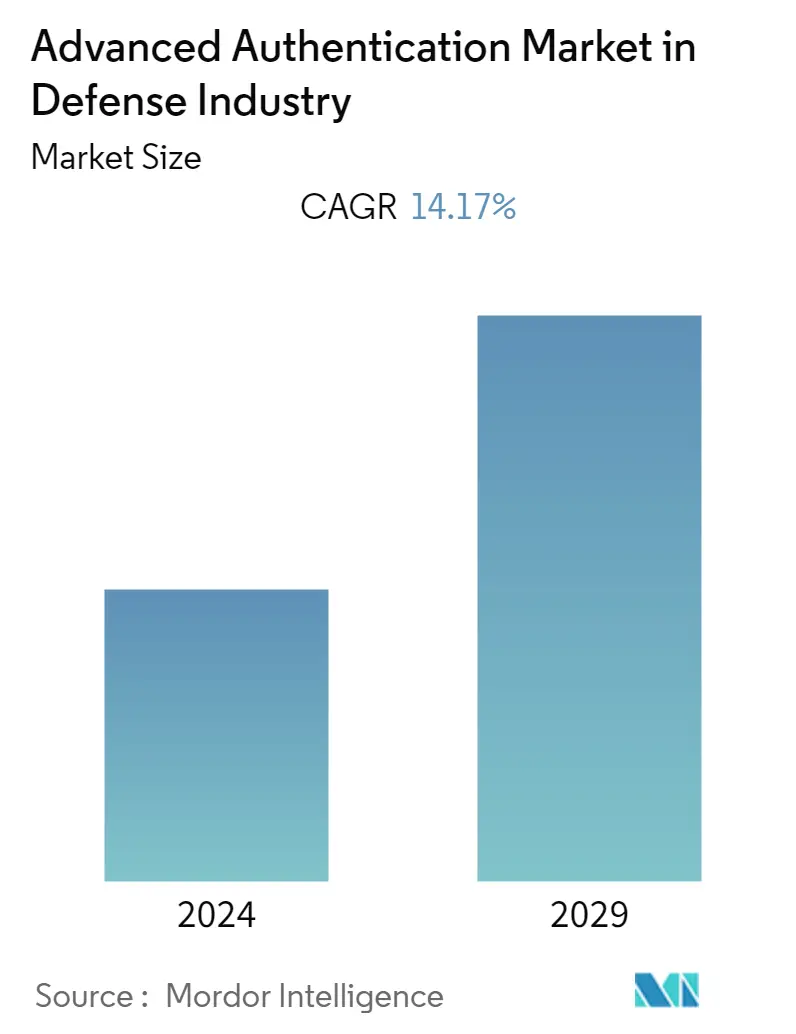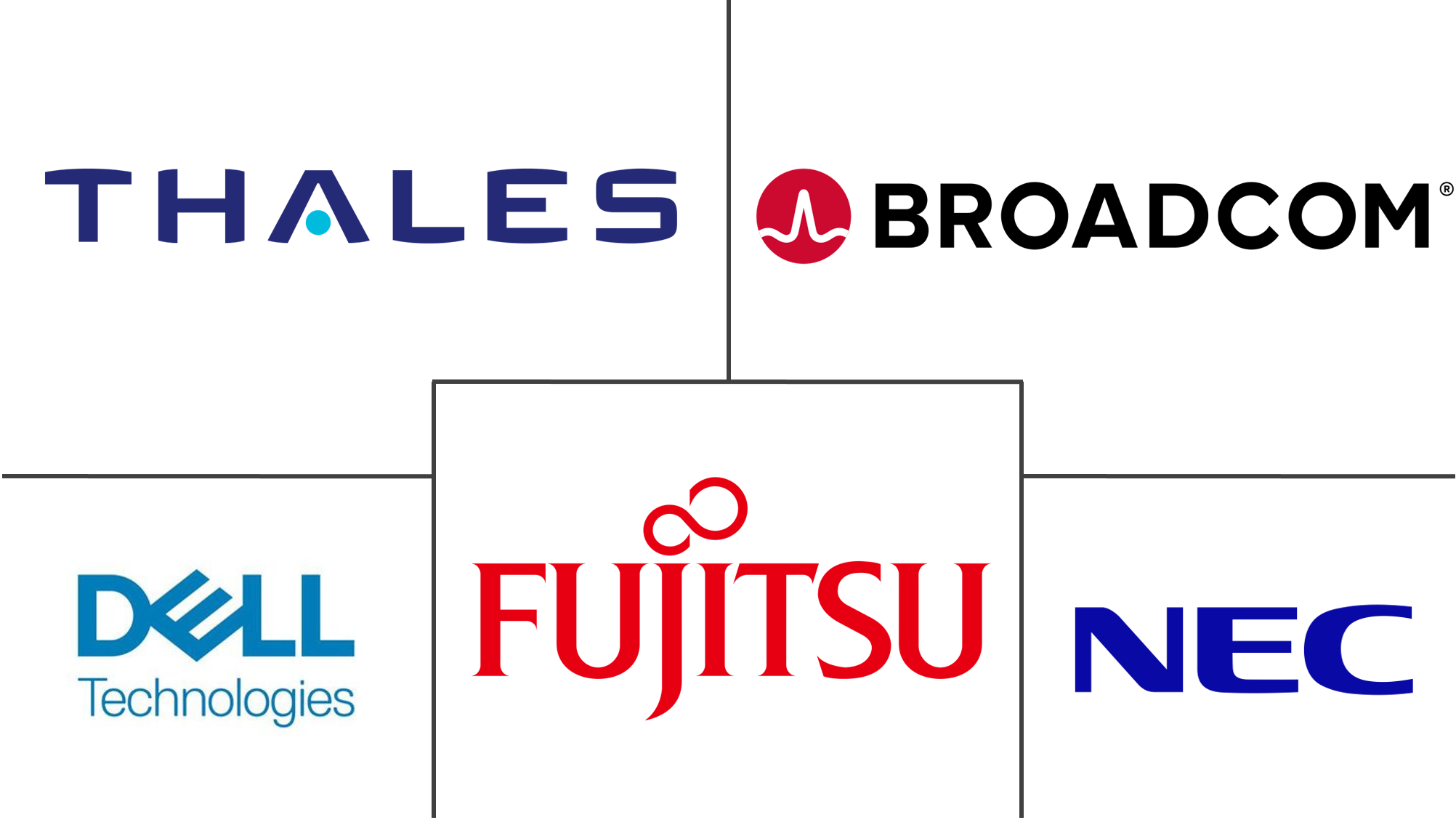Market Size of Advanced Authentication Industry in Defense Industry

| Study Period | 2019 - 2029 |
| Base Year For Estimation | 2023 |
| CAGR | 14.17 % |
| Fastest Growing Market | Asia Pacific |
| Largest Market | North America |
| Market Concentration | Low |
Major Players
*Disclaimer: Major Players sorted in no particular order |
Defense Industry Advanced Authentication Market Analysis
The Advanced Authentication Market in Defense was valued at USD 1.57 billion in 2020 and is expected to reach a value of USD 3.47 billion by 2026, at a CAGR of 14.17% over 2021-2026. As attack vectors increase with the burgeoning of the Internet of Things (IoT), the Defense sector is exposed to different risks that require increasingly advanced authentication techniques. Today's threat players are using more sophisticated social engineering tactics, credential-stuffing botnets, and account takeover tactics to pull off all sorts of attacks. According to the IBM Security's Future of Identity Report, identity fraudsters have stolen USD 112 billion over the past six years - that's approximately USD 35,600 every minute. Advanced authentication methods in Defense can help identify malicious actions while reducing unwanted speed bumps in the online experience.
- The increasing digitization of the defense industry is likely to create new avenues for cyber-criminal activities, and the risk is high as compared to any other sector. The defense industry is investing rigorously in software application and is expected to grow at a fast pace, owing to the increasing integration of digitization and connected devices. Hence, the increasing number of attacks with the rapid adoption of technologies, such as IoT, is driving the growth of the market. The defense industry contains information related to equipment and relevant data, which can be illegally utilized to vandalize a country. In addition, the companies involved in the transfer of enormous amounts of data associated with flight monitoring are the major adopters of advanced authentication.
- Companies are introducing advanced authentication, such as biometrics and iris scanners to overthrow cyber attackers. Furthermore, data about performance, technology, and service, is transferred over the internet by companies, which can be misused to steal ideas and outgrow the competitors. This is expected to drive the advanced authentication market over the forecast period. The aerospace and defense sector face persistent cyber threats from Advanced Persistent Threat (APT) groups working in association with nation-states. From stealing intellectual property to collecting intelligence that risks undermining nations' defense systems and capabilities, aerospace and defense organizations have a responsibility to ensure best practice cybersecurity is maintained.
- For example, the Associated Press (AP) reported that the Fancy Bear hacking group targeted at least 87 employees working for U.S. defense contractors via personal Gmail accounts and some corporate email accounts. If compromised, proprietary company data, such as advancements in drone and weapons research, and the U.S.'s defense could be at risk. To minimize the cyber threat it is essential that defense companies adopt the strongest form of advanced authentication for employees and suppliers by issuing and managing cryptographically protected digital identities across large numbers of employees and tier suppliers using public key infrastructure (PKI) for the most secure method of multi-factor authentication.
Defense Industry Advanced Authentication Industry Segmentation
An advanced authentication is an approach to authentication which requires the presentation of two or more of the three authentication factors: a knowledge factor - something the user knows, a possession factor - something the user has, and an inherence factor - something the user is. Advanced authentication gives a central place for all authentication systems to be managed. This is critical because companies are usually made to operate and maintain various infrastructures.
| By Authentication Methods | |
| Smartcards | |
| Biometrics | |
| Tokens | |
| User-based Public Key Infrastructure | |
| Other Methods |
| By Deployment Model | |
| On-premise | |
| Cloud |
| Geography | |
| North America | |
| Europe | |
| Asia Pacific | |
| Rest of the World |
Advanced Authentication Market in Defense Industry Size Summary
The Advanced Authentication Market in the Defense Industry is experiencing significant growth, driven by the increasing digitization and integration of connected devices within the sector. As cyber threats evolve with the proliferation of the Internet of Things (IoT), the defense industry faces heightened risks, necessitating the adoption of sophisticated authentication techniques. These methods, including biometrics and iris scanners, are crucial in safeguarding sensitive information related to defense equipment and operations. The market is characterized by a rapid pace of innovation, with major players investing in research and development to enhance security measures against advanced persistent threats and cyber-attacks. The need for robust authentication solutions is further underscored by the sector's responsibility to protect national security and maintain the integrity of defense systems.
North America holds a significant share of the advanced authentication market, with the United States leading the way due to its established infrastructure and technological advancements. The region's market growth is fueled by the increasing incidence of identity theft and ransomware attacks, prompting defense organizations to adopt advanced authentication tools to secure data. The market is highly fragmented, with several key players maintaining a considerable presence, particularly in developed economies. These companies are leveraging collaborative initiatives and continuous innovation to expand their market share and profitability. The ongoing demand for secure identity verification systems, both in military applications and civilian sectors, is expected to drive the market's expansion over the forecast period.
Advanced Authentication Market in Defense Industry Market Size - Table of Contents
-
1. MARKET DYNAMICS
-
1.1 Market Overview
-
1.2 Market Drivers
-
1.2.1 Increased Number of Cloud Users and Datacenters
-
1.2.2 Increasing Number of Security Breaches and Related Costs
-
-
1.3 Market Restraints
-
1.3.1 Privacy Concerns towards the Authentication Vendor and High Costs of Token
-
-
1.4 Industry Value Chain Analysis
-
1.5 Industry Attractiveness - Porter's Five Force Analysis
-
1.5.1 Threat of New Entrants
-
1.5.2 Bargaining Power of Buyers/Consumers
-
1.5.3 Bargaining Power of Suppliers
-
1.5.4 Threat of Substitute Products
-
1.5.5 Intensity of Competitive Rivalry
-
-
-
2. MARKET SEGMENTATION
-
2.1 By Authentication Methods
-
2.1.1 Smartcards
-
2.1.2 Biometrics
-
2.1.3 Tokens
-
2.1.4 User-based Public Key Infrastructure
-
2.1.5 Other Methods
-
-
2.2 By Deployment Model
-
2.2.1 On-premise
-
2.2.2 Cloud
-
-
2.3 Geography
-
2.3.1 North America
-
2.3.2 Europe
-
2.3.3 Asia Pacific
-
2.3.4 Rest of the World
-
2.3.5
-
-
Advanced Authentication Market in Defense Industry Market Size FAQs
What is the current Advanced Authentication Market in Defense Industry size?
The Advanced Authentication Market in Defense Industry is projected to register a CAGR of 14.17% during the forecast period (2024-2029)
Who are the key players in Advanced Authentication Market in Defense Industry?
Fujitsu Ltd, Thales Group (Gemalto N.V.), NEC Corporation, Broadcom Inc. (CA Technologies Inc.) and Dell Technologies Inc. are the major companies operating in the Advanced Authentication Market in Defense Industry.

